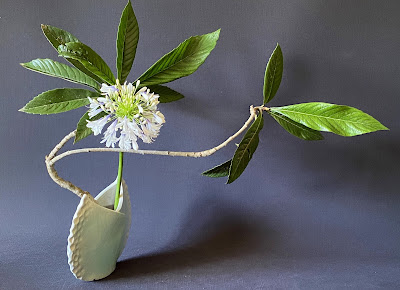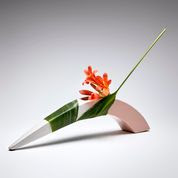Hello all,
A couple of weeks ago I featured Vicky's 'Agapanthus Galore' arrangement, for which I received a number of complementary emails. This week I'm featuring mine. We both have an overabundance of curved and straight agapanthus and, of course, we love to use them.
The arrangement, above, looks deceptively simple. The container is very accomodating in terms of the many holes into which material can be placed. However, there is no access to the inside and I needed to find a way to stop the flower stems from tipping forward. I managed to wedge a horizontal fixture using the holes to get it in, keeping the stems upright as they rested against it.
This next arrangement was done purely to showcase this special agapanthus. At first glance it appears to be an ordinary, white agapanthus. However, on closer inspection, the purple colouring of the base of each flowerette is visible. I bought this plant, called 'Queen Mum' at Heronswood House & Gardens in Dromana last year. It had one flower, which I allowed to go to seed. I then collected and sewed those seeds, which have provided me with about a dozen new plants to share with my students. I am, however, aware that when propagating from seed, the resulting plant may not be quite the same as the parent. A lot depends on which flowers the pollenation came from.
 |
| Agapanthus - Queen Mum and loquat branch |
Just before Christmas I made a number of arrangements to give away to friends and neighbours. I used pine as the basic material, which I had to clean by removing all the superfluous needles along the stems. This left me with half a bucket of pine needles and the challenge to find something to do with them. This is what I came up with:
 |
| Yes, it's a baking dish without its base and a silver bauble. Hard to believe but the pine needles would number into thousands |
Then, I resurrected a technique I tried many years ago of creating a fine mat using pine needles and spray adhesive. It took a couple of tries to get it right but, in the end, I got what I wanted.
 |
| This was the branch before I trimmed it |
 |
| The final result |
I have some news to share with you. I was recently contacted by Mrs. Taruna Agarwal, the Ikebana International president of Mumbai Chapter, asking me to run a Zoom demonstration, which will go live to their Facebook page. This is quite an honour and I accepted readily. The date for this is Saturday, the 17th January but I will post greater details later, together with the invite so that any of you who wish to join, may do so.















































